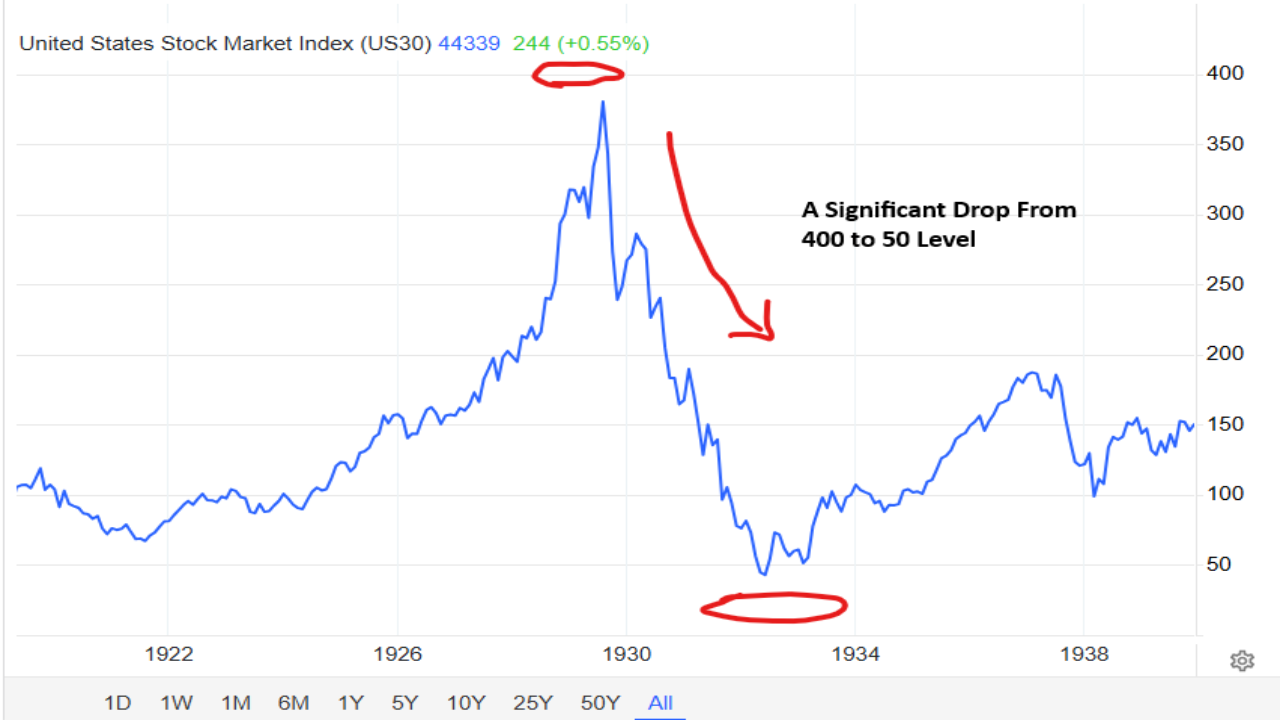Key Takeaways
- A stock market crash is a sudden decline, characterised by a significant drop in the value of the stock market.
- Traditional risk management involves utilising volume data, velocity, and modern market data, while AI can generate more efficient investment suggestions in real time.
- Diversification enables investors to have exposure in various asset classes, therefore keeping their capital safe during a stock market crash.
- intelectia.ai provide investors with AI-powered tools and suggestions.
Introduction
Stock market crashes are very common for investors in the financial market; in many cases, they occur without warning and decline significantly, causing investors to panic. This downturn creates confusion, wipes out a significant portion of investment, and causes long-term financial setbacks.
Stock market crashes occur primarily due to economic uncertainty, geopolitical tensions, shifts in investor sentiment, and other factors, for instance, the Great Depression in 1929 and the COVID-19 market crash.
Experts combine evolving technology with decades of financial data to develop cutting-edge tools and identify time-tested investment methods that manage risks during stock market crashes. Platforms like Intellectia.ai are transforming how investors can utilize AI to predict and respond to unusual volatility in real time.

Understanding Stock Market Crashes
A stock market crash is a sudden decline, characterised by a significant drop in the value of the stock market. During that period, the market can decline 20% or above, whereas experts define a 10% decline as “corrections”. This can occur for various reasons, including geopolitical uncertainties, economic slowdowns, shifts in investor sentiment, and others. For instance, the Great Depression of 1929, Black Monday in 1987, the Global Financial Crisis in 2008, and the COVID-19 pandemic impact in 2020.
The Great Depression occurred in the United States in 1929 and lasted until 1939, a remarkable period for the industrial Western world. This is what originated in the United States but ultimately impacted most countries worldwide, leading to unemployment, output decline, and tremendous deflation, among other consequences, and driving fundamental changes in government monetary and economic policy.
On Black Monday, 1987, the Dow Jones fell by approximately. 22% in a single day! The Nasdaq Composite index lost over 75% in 2000, following the burst of the dot-com bubble, and then again during the financial crisis of 2008, which was triggered by banking sector failures. These historical crashes declare that the market does not always follow the trend, and a sudden massive decline can occur.

In most cases, the market crash initiates with a negative sentiment, which may be due to political uncertainty, geopolitical tensions, poor earnings, monetary policy shifts, etc. These events might trigger panic selling, and investors can experience significant losses on their investments. It can trigger margin calls for investors, leading them to bankruptcy. Besides burning portfolios, a stock market crash can have a profound impact on the economy, resulting in job losses and a decline in consumer confidence. These underscore the importance of efficient portfolio management.
Building a Defensive Portfolio
A defensive portfolio is a common investment technique that investors use to mitigate risks and ensure capital protection. The design of a defensive portfolio primarily prioritises protecting the asset as a safeguard, then focuses on modest growth. Building a defensive portfolio involves investing in sectors or assets that are less sensitive during economic downturns, such as healthcare, utilities, and consumer staples. These defensive stocks typically have solid demand, as they often provide essential services and are less sensitive to market fluctuations, preserving value as safe-haven assets during periods of uncertainty.
The defensive stock portfolio can include assets like,
- Healthcare: The healthcare sector encompasses companies that produce healthcare products, medicines, treatments, and other related goods and services for the diagnosis, treatment, and prevention of diseases. Pharmaceutical companies and other healthcare-related organisations are part of this sector. Health is a universal concern, and healthcare needs remain constant during any economic turbulence, making these stocks less volatile and attractive during a crisis. Ongoing medications, treatments, and necessary products and services make these stocks attractive for investors to generate moderate income, especially during economic downturn.
- Utilities: The utilities sector comprises companies that provide essential goods and services, such as water, gas, electricity, and others. These are mandatory for consumers in everyday life. So, no wonder the demand remains somewhat stable. This consistent demand makes these stocks less volatile during economic turbulence. Stocks in this sector often offer attractive dividends, providing a stable income source and protecting capital.
- Consumer Staples: The consumer staple sector encompasses products and services that cater to everyday needs, including food, beverages, personal care items, household products, and more. These are non-negotiable products even during tough economic times. So, no wonder stocks in this sector remain less volatile and stable, safeguarding your wealth and even growing moderately during a crisis.
There are non-correlated assets that are attractive to investors when creating a defensive portfolio during recession or economic decline, such as Gold. The precious metal even moves in the opposite direction during a downturn, as investors view it as a “safe-haven” asset. The safe-haven demand increases when an economic slowdown occurs, as it has been proven that asset values continue to rise during periods of high inflation, geopolitical instability, and financial uncertainty.
The chart above shows the price performance of the United States stock market (blue line) and the Gold (green line). It illustrates that when the stock market continues to decline, safe-haven demand suddenly increases, driving the precious metal's price higher. Gold doesn’t generate income like bonds or stocks; it usually preserves value during economic uncertainty and protects capital from downturns. These are the reasons investors choose gold for their defensive portfolio to preserve their capital and potentially make considerable profits. Investors can invest in gold in several ways, rather than just storing physical gold, such as through ETFs, gold mining stocks, and other options.
A defensive portfolio also includes investing in treasury bond notes, which have a short maturity, and blue-chip stocks. Including these assets in the portfolio enables investors to mitigate risks in the event of a stock market crash and preserve capital for future growth.
Using AI Tools for Risk Management
The financial market is evolving, and artificial intelligence (AI) is emerging as a transformative force in the marketplace, particularly in the risk management sector. Traditional risk management involves utilising volume data, velocity, and modern market data, among other factors. AI can generate more efficient investment suggestions based on all this essential data in real time.
Artificial intelligence can examine vast datasets, identify patterns, and suggest anticipated insights to investors, enabling them to make more informed and efficient trade decisions for effective portfolio management.
AI-powered platforms, such as Intellectia.ai, introduce cutting-edge tools for advanced risk management and trend analysis. They utilize machine learning algorithms that can interpret and process financial indicators, historical market data, geopolitical events, and other relevant factors. AI continues to learn and adapt, and is capable of processing vast amounts of data within a short period, whereas humans can miss details and have limitations.
Using AI tools for risk management includes
- Predictive Risk Modelling: AI can create predictive risk models to anticipate potential risks. It can determine underperforming assets during certain microeconomic conditions and alert investors.
- Real Time Volatility Analysis: Artificial intelligence is capable of monitoring volatility, spikes, or unusual price movements and signaling a potential downward or risky environment. It can generate these ideas by collecting various market data, such as volume, price movements, and order books.
- Hidden Correlation: Markets are highly correlated, and AI can determine the hidden correlations by analysing complex market data. For example, AI might detect how changes in commodity prices might impact tech stocks for a specific region.
- Sentiment Analysis: AI can process a significant amount of data from social media posts, blogs, articles, news, and economic forums. By processing all this data, AI can gauge the market sentiment for any specific asset. Detecting fear or optimism for any sector or asset through AI can help investors manage their portfolios more efficiently, reducing risks.
- Adaptive Learning: Analogue or static methods have limitations or follow specific rules, whereas AI can process vast market data and continues to adapt concepts. This is another positive feature that investors may find helpful when making trade decisions or managing their portfolios.
Diversification and Asset Allocation
Diversification and asset allocations are important aspects for investors for portfolio management, especially during a stock market crash. Diversification is another method that enables investors to avoid putting all their eggs in the same basket.
Diversification involves putting capital into different sectors, for example:
- Equities: Equities, also known as stocks, enable investors to own shares in companies that offer attractive dividends and potential capital appreciation. It involves risks but has long-term growth potential. Intelectia.ai provides tools such as a financial AI agent, a Stock monitor tool, and technical analysis for assets, which may help you make informed trade decisions.
- Fixed Income Asset: Fixed income assets as government bonds, may offer less income than stocks, but remain less volatile and provide continuous income over the period.
- Real Estate: Real estate assets offer diversification and can even provide a long-term hedge against inflation.
- Commodities: Commodities like raw materials such as gold, silver, etc. During a stock market crash, these assets are preferable for protecting capital and even generating profits.
- Exchange-Traded Funds (ETFs): ETFs play a crucial role in diversification and asset allocation. It helps investors achieve broader market exposure by transitioning from a single asset to an asset class, sector, or industry.
Diversification enables investors to have exposure in various asset classes, therefore keeping their capital safe during a stock market crash. Besides following your own strategy focusing on what experts are doing can be a way to expand your portfolio. Intellectia.ai hedge fund Tracker is a tool that allows you to track what Hedge funds are doing with their investments.
Conclusion
The stock market crash is an unwanted situation that investors face, and there are several ways to navigate it successfully during that period. AI enables investors to assess their risk tolerance and asset allocation by processing vast amounts of market data, and platforms like intelectia.ai provide investors with AI-powered tools and suggestions. Don’t hesitate to sign up today and check offerings to utilise your capital using the best methods. The platform offers a stock picker and an AI screener, helping investors choose the right asset. It also offers a stock monitor, an AI agent, stock technical analysis, a hedge fund tracker, and so on. You can utilize these tools effectively to make informed trade decisions and manage your portfolio efficiently.









